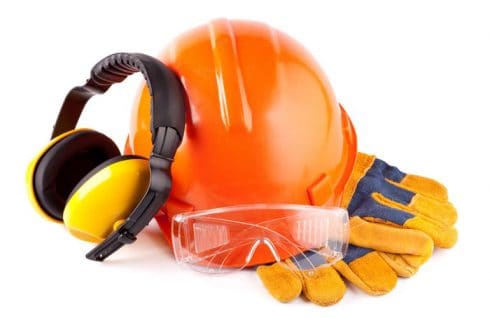Safety Talks – PPE

Personal Protective Equipment or PPE for short, help to protect against various workplace hazards. Controlling a hazard at its source is the best way to protect employees. However, depending on the hazard, administrative or engineering controls may not be enough.
When to wear PPE:
- Before resorting to PPE
- Use Administrative Controls
- Does this job need to be done?
- Can you use multiple people at different times so one person isn’t exposed to a hazard for an extended period of time?
- Implement Engineering Controls
- Use local exhaust or general ventilation vs. a respirator
- Control dust with a wet process vs. dry
- Install sound reducing devices to mechanical equipment
- Use Administrative Controls
- When these two means of protection are exhausted you then will need to select the appropriate PPE. Most of the time PPE is used in conjunction with administrative and engineering controls for added protection.
Basic Types of PPE:
Head Protection (protection from falling, bumping, splashing, electrical hazards)
- Hard Hat (are divided into three industrial classes)
- Class A: provide impact and penetration resistance along with limited voltage protection (up to 2,200 volts).
- Class B: provide the highest level of protection against electrical hazards, with high-voltage shock and burn protection (up to 20,000 volts). They also provide protection from impact and penetration hazards by flying/falling objects.
- Class C: provide lightweight comfort and impact protection but offer no protection from electrical hazards.
Hearing Protection (over 90 Decibels for 8 hrs a day requires hearing protection)
- Ear Muffs: One size fits all, comfortable, less ear infection risk.
- Ear Plugs: Small, lightweight, can get dirty and cause infections.
- Pre-formed or molded earplugs – must be individually fitted by a professional and can be disposable or reusable. Reusable plugs should be cleaned after each use.
- Single-use earplugs – are made of waxed cotton, foam, silicone rubber or fiberglass wool. They are self-forming and, when properly inserted, they work as well as most molded earplugs.
Face/Eye Protection (working with chemicals or using any mechanical equipment)
- Face Shield: Protect face from splashing and particles from hazardous liquids but offer no protection from impact hazards.
- Safety Glasses: Provide good protection from impact hazards. Safety frames are constructed from metal or plastic and lenses are impact-resistant. Wearing glasses with side shields are recommended.
- Safety Goggles: Tight-fitting eye protection that completely cover the eyes and the facial area surrounding the eyes. Good protection from impact, dust and splashing hazards. Some goggles will fit over corrective lenses.
Hand Protection (use the correct glove for the job)
Leather, Canvas or Metal Mesh Gloves
- Leather Gloves: Protect against sparks, moderate heat, blows, chips and rough objects.
- Aluminized Gloves: Provide reflective and insulating protection against heat and require an insert made of synthetic materials to protect against heat or cold.
- Aramid fiber Gloves: Protect against heat and cold, are cut- and abrasive-resistant and wear well.
- Synthetic Gloves: Made of various materials and offer protection against heat and cold, are cut- and abrasive-resistant and may withstand some diluted acids. These materials do not stand up against alkalis and solvents.
Fabric or Fabric Coated Gloves
- Fabric Gloves: Protect against dirt, slivers, chafing and abrasions.
- Coated Fabric Gloves: These gloves are used for tasks ranging from handling bricks and wire to chemical laboratory containers.
Chemical and Liquid-Resistant Gloves
- Butyl Gloves: Made of a synthetic rubber and protect against a wide variety of chemicals.
- Natural (latex) Rubber Gloves: Are popular for general purpose use featuring great tensile strength, elasticity and temperature resistance.
- Neoprene Gloves: Made of synthetic rubber and offer chemical and wear resistance properties superior to those made of natural rubber.
- Nitrile Gloves: Offer protection when working with oils, greases, acids, caustics and alcohols but are generally not recommended for use with strong oxidizing agents, aromatic solvents, ketones and acetates.
Body Protection
Protective clothing comes in a variety of materials, each effective against particular hazards, such as:
- Paper-like Fiber: used for disposable suits and provide protection against dust and splashes.
- Treated wool and cotton: Adapts well to changing temperatures, fire-resistant and protects against dust, abrasions and rough, irritating surfaces.
- Duck: Closely woven cotton fabric that protects against cuts and bruises when handling heavy, sharp or rough materials.
- Leather: Often used to protect against dry heat and flames.
- Rubber, rubberized fabrics, neoprene and plastics: Provide protection against certain chemicals and physical hazards. Check with the manufacturer to ensure the material will provide proper protection against the specific hazard.
Foot Protection
- Safety Shoes: Have impact-resistant toes and heat-resistant soles that protect the feet against hot work surfaces. Metal insoles of some safety shoes protect against puncture wounds. Some safety shoes may also be designed to be electrically conductive to prevent buildup of static electricity in areas with the potential for explosive atmospheres.
Care for your PPE
With all protective equipment, you should inspect your gear before each use. Any excessive wear or breakdown of materials indicates the need to replace the equipment. If you’re ever in doubt as to whether or not to replace a piece of PPE, be on the safe side and replace it instead of ignoring the signs of worn out or faulty equipment.
